Numerical Simulation Study of Seafloor Hydrothermal Circulation Based on HydrothermalFoam: A Case Study of the Wocan-1 Hydrothermal Field, Carlsberg Ridge, Indian Ocean
Abstract
:1. Introduction
2. Mathematical Models and Governing Equations
2.1. Governing Equations
2.2. Solution Algorithm
3. Model Parameter Configuration and Computational Conditions
3.1. Grid Configuration and Boundary Conditions
3.2. Model Parameter Settings
3.3. Numerical Simulation Conditions
4. Results and Discussion
4.1. Hydrothermal Fluid Temperature and Its Influencing Factors
4.2. Velocity Field of Hydrothermal Fluid
4.3. Relationship between Element Concentration at the Vent and the Concentration at the Bottom
5. Conclusions
- This paper constructs a numerical model for the hydrothermal region of the Carlsberg Ridge Worm-1 in the Indian Ocean. This model successfully reproduces the typical hydrothermal circulation processes of oceanic crust, yielding data on temperature distribution, flow field structure, and elemental concentration distribution. After simulating for a certain period, the depth and temperature of potential heat sources in the Worm-1 hydrothermal region are inferred based on the vent data. The maximum temperature of the heat source Tmax = 823K (550 °C) and the depth of the heat source h = 1 km are possible results. The model can be further refined with more field data in the future, making the results more targeted.
- A sensitivity analysis was carried out on the temperature and depth of the heat source. This analysis highlighted their pronounced effects on the fluid temperature at the vent. Specifically, within a certain range, the temperature of the heat source positively correlates with the fluid temperature at the vent. Similarly, the depth of the heat source also shows a positive correlation with the fluid temperature at the vent.
- In this study, we initially addressed the kinetic processes of elemental transport within hydrothermal circulation. While neglecting the impacts of chemical reactions among elements and microbial influences on the transport, an empirical relationship was formulated between the elemental concentration at the bottom boundary and the fluid elemental concentration at the vent: Cvent = 0.26 Cboundary. Future research can incorporate the effects of chemical reactions and microbial influences on elemental transport and related work will be carried out in the next step.
Author Contributions
Funding
Institutional Review Board Statement
Informed Consent Statement
Data Availability Statement
Conflicts of Interest
References
- Hasenclever, J.; Theissen-Krah, S.; Rüpke, L.H.; Morgan, J.P.; Iyer, K.; Petersen, S.; Devey, C.W. Hybrid Shallow On-Axis and Deep off-Axis Hydrothermal Circulation at Fast-Spreading Ridges. Nature 2014, 508, 508–512. [Google Scholar] [CrossRef]
- Elderfield, H.; Schultz, A. Mid-Ocean Ridge Hydrothermal Fluxes and the Chemical Composition of the Ocean. Annu. Rev. Earth Planet. Sci. 1996, 24, 191–224. [Google Scholar] [CrossRef]
- Hodgkinson, M.R.S.; Webber, A.P.; Roberts, S.; Mills, R.A.; Connelly, D.P.; Murton, B.J. Talc-Dominated Seafloor Deposits Reveal a New Class of Hydrothermal System. Nat. Commun. 2015, 6, 10150. [Google Scholar] [CrossRef]
- Jiang, Z.; Han, X.; Wang, Y. Characteristics of water chemistry and constituents of particles in the hydrothermal plume near 6° 48′ N, Carlsberg Ridge, Northwest Indian Ocean. J. Mar. Sci. 2017, 35, 34–43. (In Chinese) [Google Scholar]
- Olatunde Popoola, S.; Han, X.; Wang, Y.; Qiu, Z.; Ye, Y. Geochemical Investigations of Fe-Si-Mn Oxyhydroxides Deposits in Wocan Hydrothermal Field on the Slow-Spreading Carlsberg Ridge, Indian Ocean: Constraints on Their Types and Origin. Minerals 2018, 9, 19. [Google Scholar] [CrossRef]
- Qiu, Z.; Han, X.; Wang, Y.; Chen, X.; Garbe-Schönberg, D.; Fan, W.; Li, H.; Liu, J. Time-Series Records of Particulate Fluxes Reveal Temporal Variations in Hydrothermal Activity in the Wocan Hydrothermal Field, Carlsberg Ridge. Mar. Geol. 2023, 460, 107056. [Google Scholar] [CrossRef]
- Weis, P.; Driesner, T.; Coumou, D.; Geiger, S. Hydrothermal, Multiphase Convection of H2O-NaCl Fluids from Ambient to Magmatic Temperatures: A New Numerical Scheme and Benchmarks for Code Comparison. Geofluids 2014, 14, 347–371. [Google Scholar] [CrossRef]
- Ingebritsen, S.E.; Geiger, S.; Hurwitz, S.; Driesner, T. Numerical Simulation of Magmatic Hydrothermal Systems. Rev. Geophys. 2010, 48, RG1002. [Google Scholar] [CrossRef]
- Tao, C.; Seyfried, W.E.; Lowell, R.P.; Liu, Y.; Liang, J.; Guo, Z.; Ding, K.; Zhang, H.; Liu, J.; Qiu, L.; et al. Deep High-Temperature Hydrothermal Circulation in a Detachment Faulting System on the Ultra-Slow Spreading Ridge. Nat. Commun. 2020, 11, 1300. [Google Scholar] [CrossRef]
- He, Z.; Han, X.; Qiu, Z.; Wang, Y.; Lou, Y. Numerical modeling of hydrodynamic processes of deep-sea hydrothermal plumes: A case study on Daxi hydrothermal field, Carlsberg Ridge. Sci. Sin.-Technol. 2020, 50, 194–208. [Google Scholar] [CrossRef]
- Yapparova, A.; Gabellone, T.; Whitaker, F.; Kulik, D.A.; Matthäi, S.K. Reactive Transport Modelling of Dolomitisation Using the New CSMP++GEM Coupled Code: Governing Equations, Solution Method and Benchmarking Results. Transp. Porous Med. 2017, 117, 385–413. [Google Scholar] [CrossRef]
- Theissen-Krah, S.; Iyer, K.; Rüpke, L.H.; Morgan, J.P. Coupled Mechanical and Hydrothermal Modeling of Crustal Accretion at Intermediate to Fast Spreading Ridges. Earth Planet. Sci. Lett. 2011, 311, 275–286. [Google Scholar] [CrossRef]
- Pierre, S.; Gysi, A.P.; Monecke, T. Fluid Chemistry of Mid-Ocean Ridge Hydrothermal Vents: A Comparison between Numerical Modeling and Vent Geochemical Data. Geofluids 2018, 2018, 1389379. [Google Scholar] [CrossRef]
- Fan, Q.; Li, J. Study on the influence of the structure of oceanic crust permeability on the hydrothermal convection—Based on thermodynamic modelling. Chin. J. Geophys. 2020, 63, 1986–1997. (In Chinese) [Google Scholar]
- Kamesh Raju, K.A.; Chaubey, A.K.; Amarnath, D.; Mudholkar, A. Morphotectonics of the Carlsberg Ridge between 62°20′ and 66°20′E, Northwest Indian Ocean. Mar. Geol. 2008, 252, 120–128. [Google Scholar] [CrossRef]
- Tao, C.; Wu, G.; Deng, X.; Qiu, Z.; Han, C.; Long, Y. New discovery of seafloor hydrothermal activity on the Indian Ocean Carlsberg Ridge and Southern North Atlantic Ridge—Progress during the 26th Chinese COMRA cruise. Acta Oceanol. Sin. 2013, 32, 85–88. [Google Scholar] [CrossRef]
- Wang, Y.; Han, X.; Petersen, S.; Frische, M.; Qiu, Z.; Li, H.; Li, H.; Wu, Z.; Cui, R. Mineralogy and Trace Element Geochemistry of Sulfide Minerals from the Wocan Hydrothermal Field on the Slow-Spreading Carlsberg Ridge, Indian Ocean. Ore Geol. Rev. 2017, 84, 1–19. [Google Scholar] [CrossRef]
- Qiu, Z.; Han, X.; Li, M.; Wang, Y.; Chen, X.; Fan, W.; Zhou, Y.; Cui, R.; Wang, L. The Temporal Variability of Hydrothermal Activity of Wocan Hydrothermal Field, Carlsberg Ridge, Northwest Indian Ocean. Ore Geol. Rev. 2021, 132, 103999. [Google Scholar] [CrossRef]
- Wang, K.; Han, X.; Wang, Y.; Cai, Y.; Qiu, Z.; Zheng, X. Numerical Simulation-Based Analysis of Seafloor Hydrothermal Plumes: A Case Study of the Wocan-1 Hydrothermal Field, Carlsberg Ridge, Northwest Indian Ocean. J. Mar. Sci. Eng. 2023, 11, 1070. [Google Scholar] [CrossRef]
- Sander, S.G.; Koschinsky, A. Metal Flux from Hydrothermal Vents Increased by Organic Complexation. Nat. Geosci. 2011, 4, 145–150. [Google Scholar] [CrossRef]
- Xie, Q.; Han, X.; Wei, M.; Qiu, Z.; Dong, C.; Wu, Y.; Wu, X.; Yu, J. Characteristics and evolution of bacterial communities in the Wocan hydrothermal plume-influenced zone, Carlsberg Ridge, northwestern Indian Ocean. Acta Microbiol. Sin. 2022, 62, 1974–1985. (In Chinese) [Google Scholar] [CrossRef]
- Wei, M.; Zeng, X.; Han, X.; Shao, Z.; Xie, Q.; Dong, C.; Wang, Y.; Qiu, Z. Potential Autotrophic Carbon-Fixer and Fe(II)-Oxidizer Alcanivorax Sp. MM125-6 Isolated from Wocan Hydrothermal Field. Front. Microbiol. 2022, 13, 930601. [Google Scholar] [CrossRef] [PubMed]
- Li, J.; Mara, P.; Schubotz, F.; Sylvan, J.B.; Burgaud, G.; Klein, F.; Beaudoin, D.; Wee, S.Y.; Dick, H.J.B.; Lott, S.; et al. Recycling and Metabolic Flexibility Dictate Life in the Lower Oceanic Crust. Nature 2020, 579, 250–255. [Google Scholar] [CrossRef] [PubMed]
- Guo, Z.; Rüpke, L.; Tao, C. HydrothermalFoam v1.0: A 3-D Hydrothermal Transport Model for Natural Submarine Hydrothermal Systems. Geosci. Model. Dev. 2020, 13, 6547–6565. [Google Scholar] [CrossRef]
- Lowell, R.P.; Gosnell, S.; Yang, Y. Numerical Simulations of Single-pass Hydrothermal Convection at Mid-Ocean Ridges: Effects of the Extrusive Layer and Temperature-dependent Permeability. Geochem. Geophys. Geosyst. 2007, 8, Q10011. [Google Scholar] [CrossRef]
- Lowell, R.P.; Yao, Y. Anhydrite Precipitation and the Extent of Hydrothermal Recharge Zones at Ocean Ridge Crests. J. Geophys. Res. 2002, 107, 2183. [Google Scholar] [CrossRef]
- Chen, Y.; Lou, Y.; He, Z.; Wang, Y.; Qiu, Z.; Han, X. Flow fields and outputs of the hydrothermal plume at the Wocan-1 field based on an in-situ video. Sci. Sin.-Technol. 2022, 52, 1705–1715. [Google Scholar] [CrossRef]
- Lowell, R.P.; Farough, A.; Hoover, J.; Cummings, K. Characteristics of Magma-driven Hydrothermal Systems at Oceanic Spreading Centers. Geochem. Geophys. Geosyst. 2013, 14, 1756–1770. [Google Scholar] [CrossRef]
- Baker, E.T.; Massoth, G.J. Characteristics of Hydrothermal Plumes from Two Vent Fields on the Juan de Fuca Ridge, Northeast Pacific Ocean. Earth Planet. Sci. Lett. 1987, 85, 59–73. [Google Scholar] [CrossRef]
- Kretschmar, U.; McBride, D. The Metallogeny of Lode Gold Deposits: A Syngenetic Perspective; Elsevier: Amsterdam, The Netherlands, 2015; pp. 151–198. [Google Scholar] [CrossRef]
- Jupp, T.E.; Schultz, A. Physical Balances in Subseafloor Hydrothermal Convection Cells. J. Geophys. Res. 2004, 109, B05101. [Google Scholar] [CrossRef]
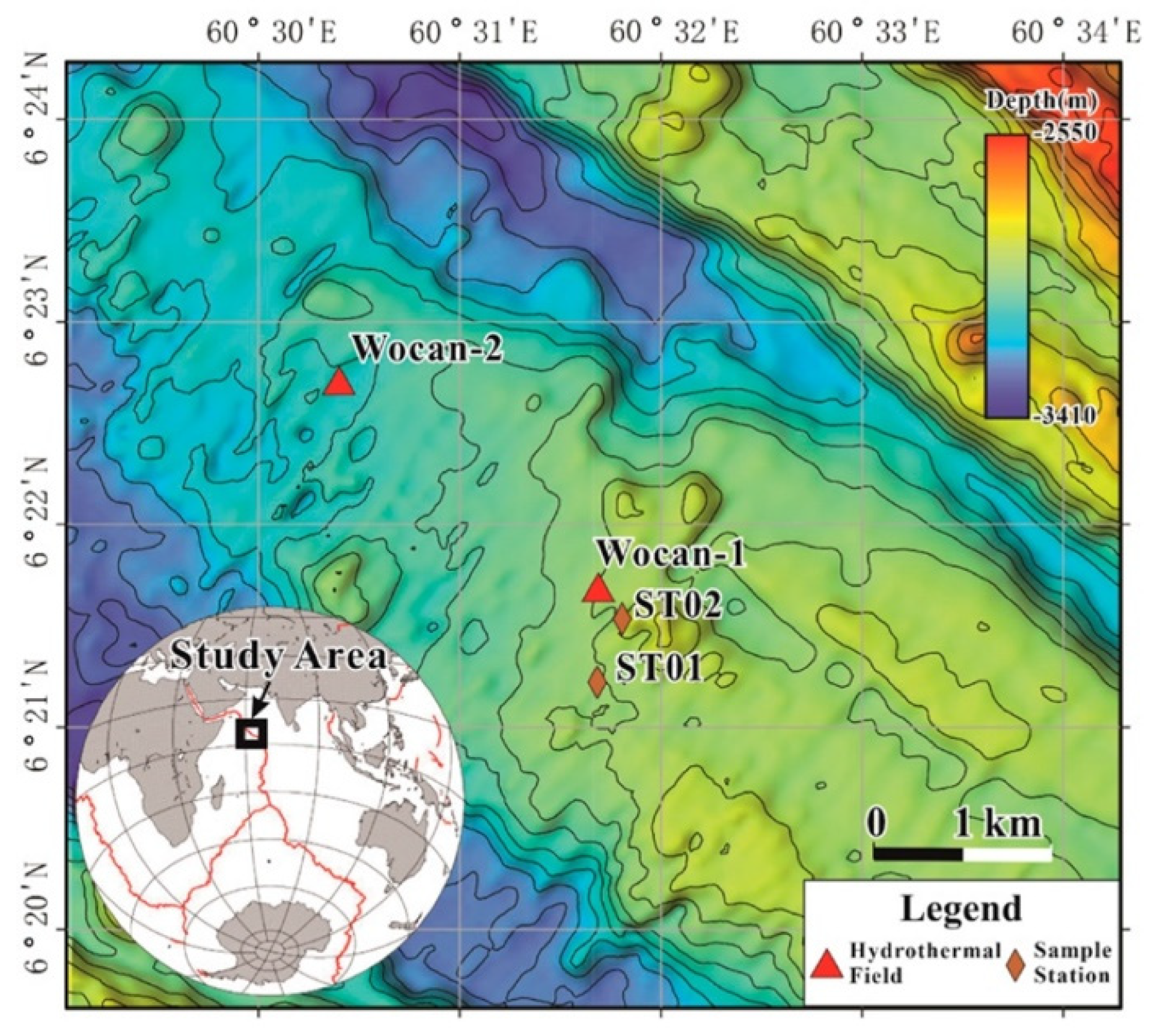


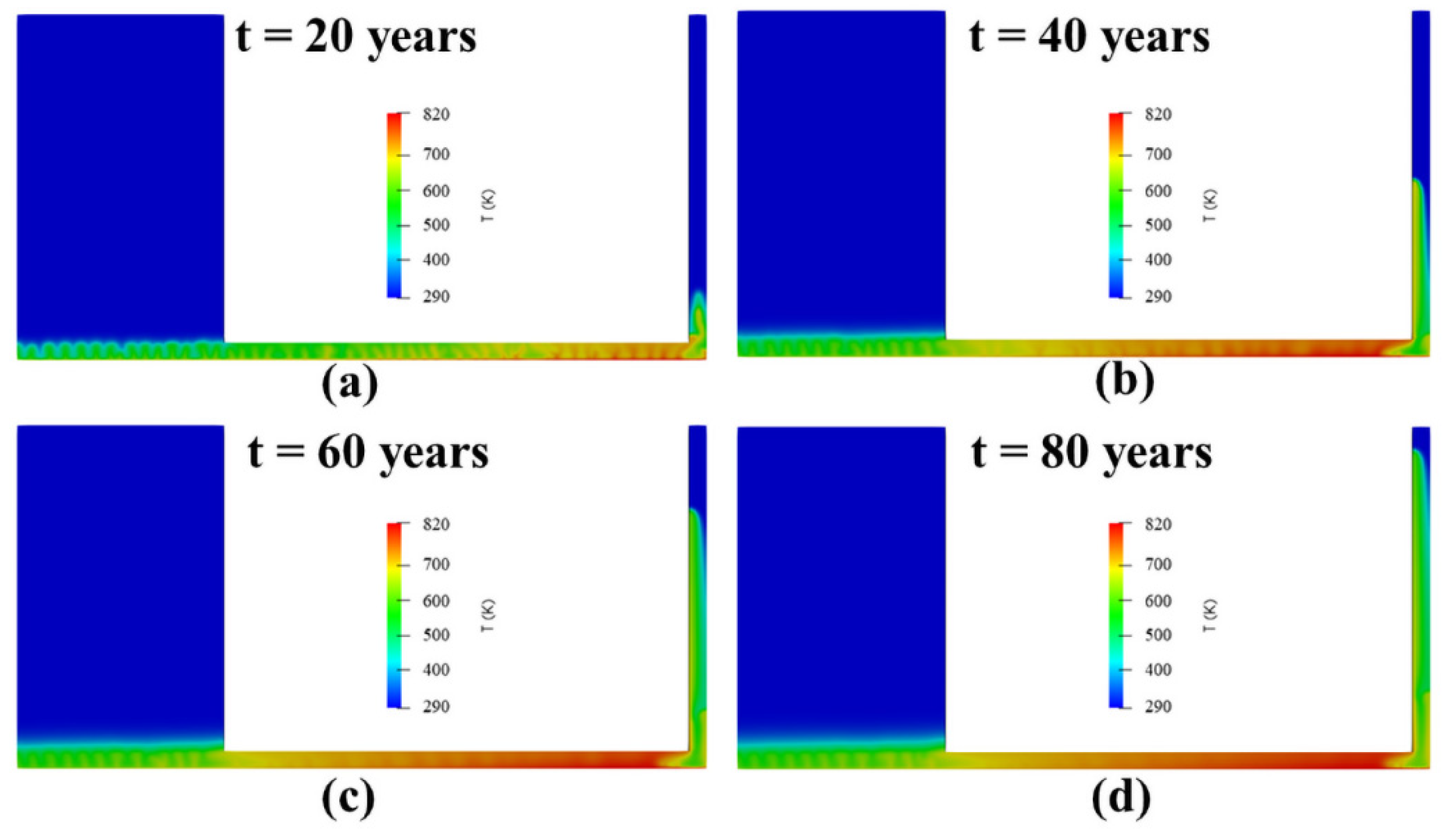
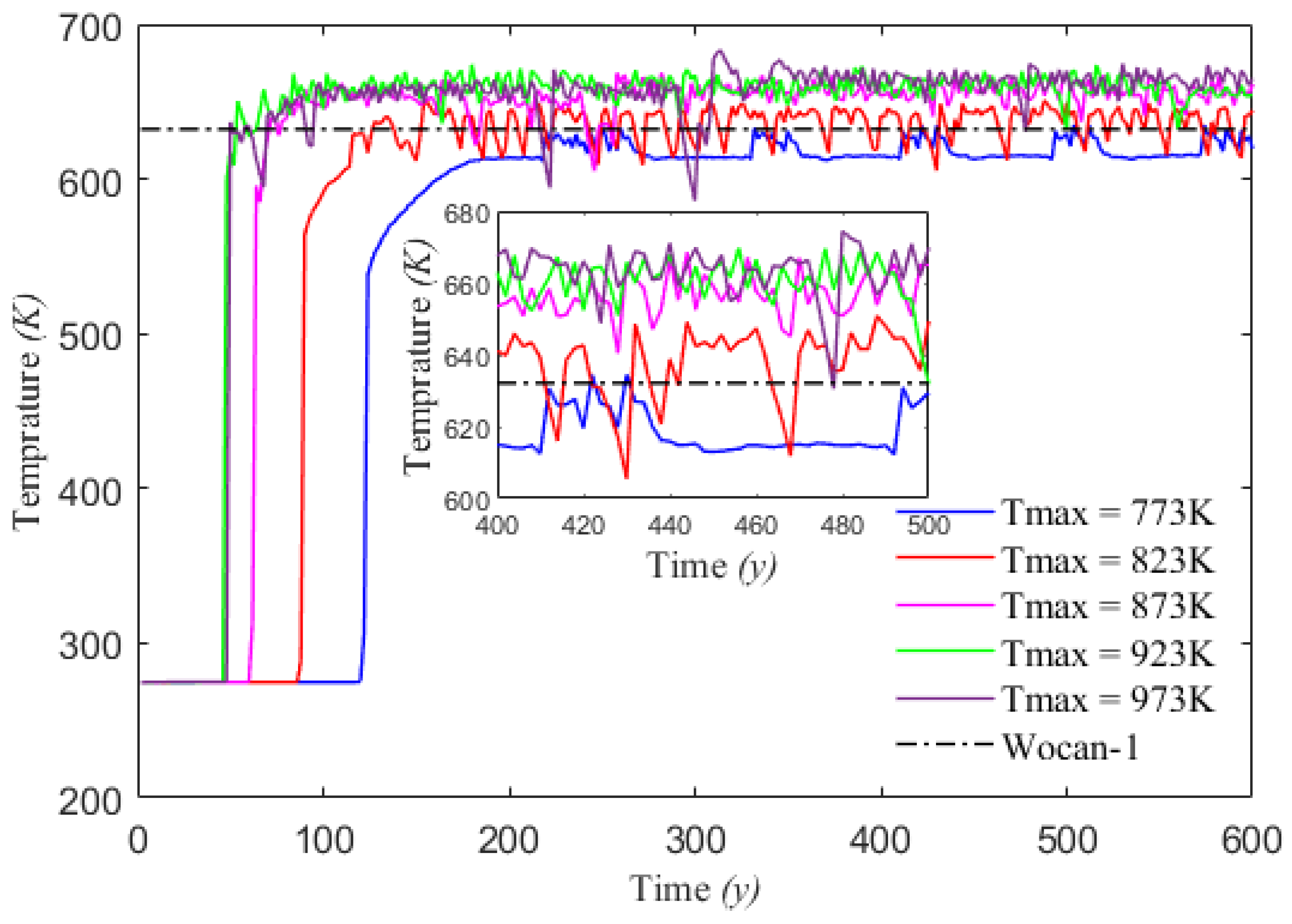
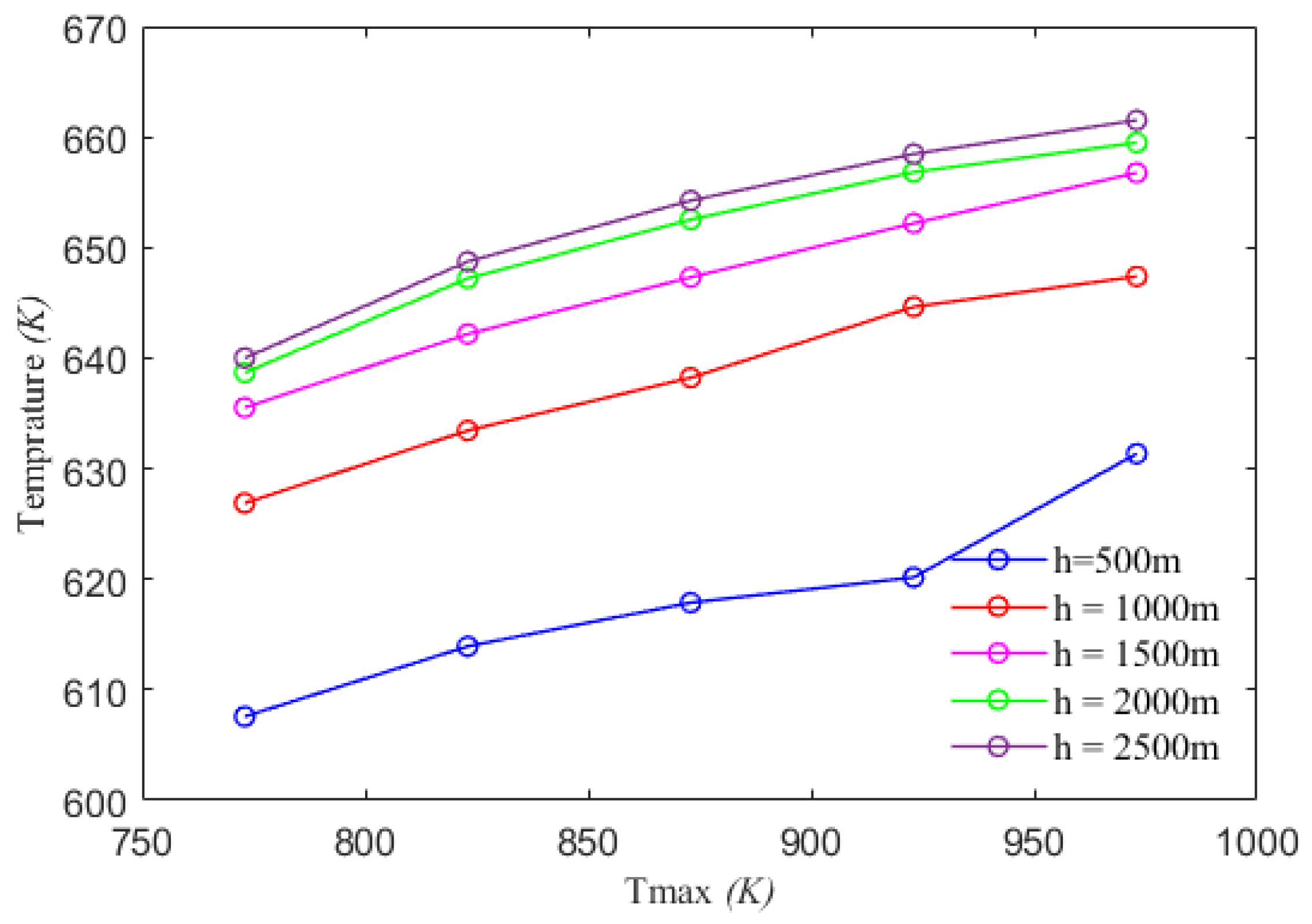
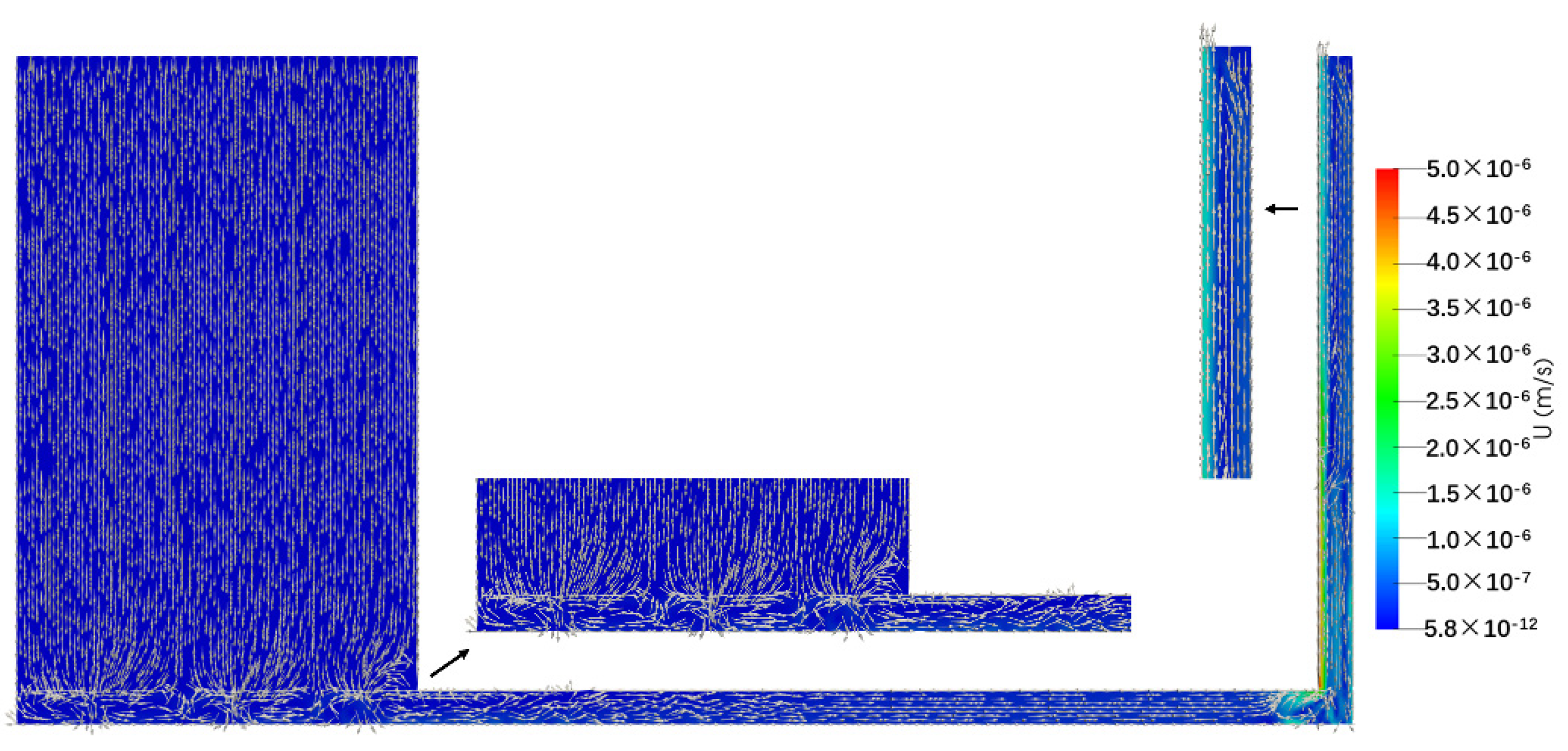
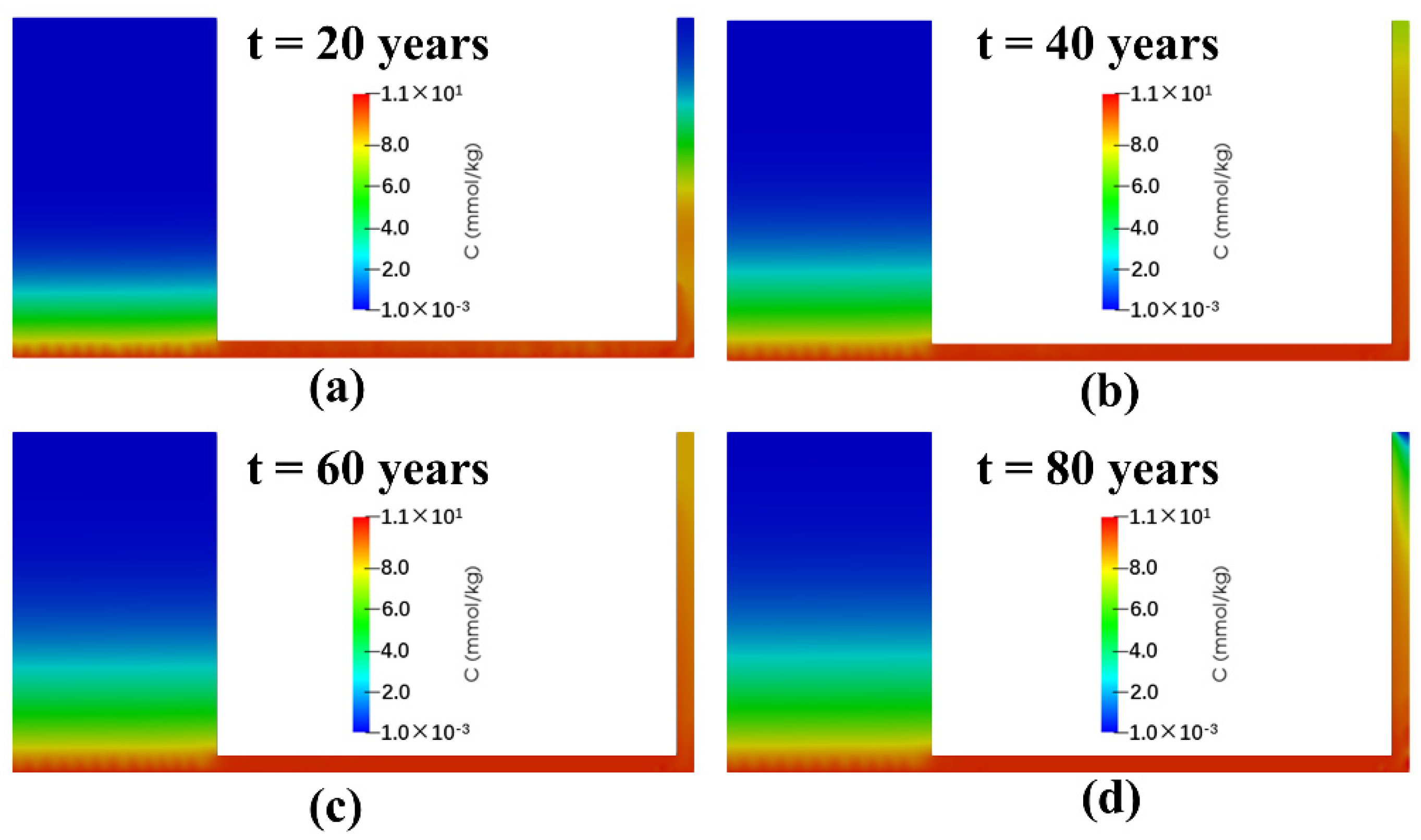
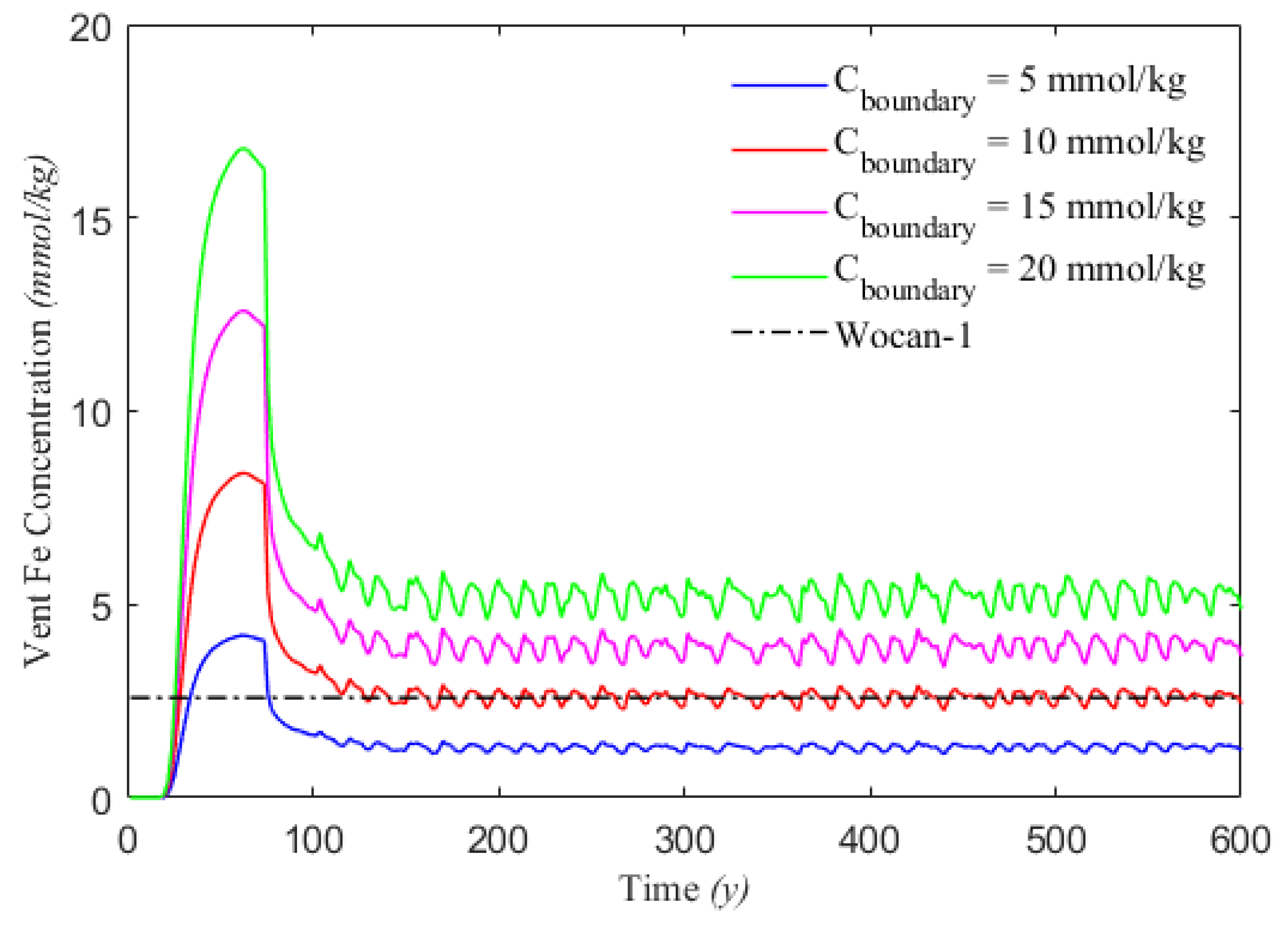
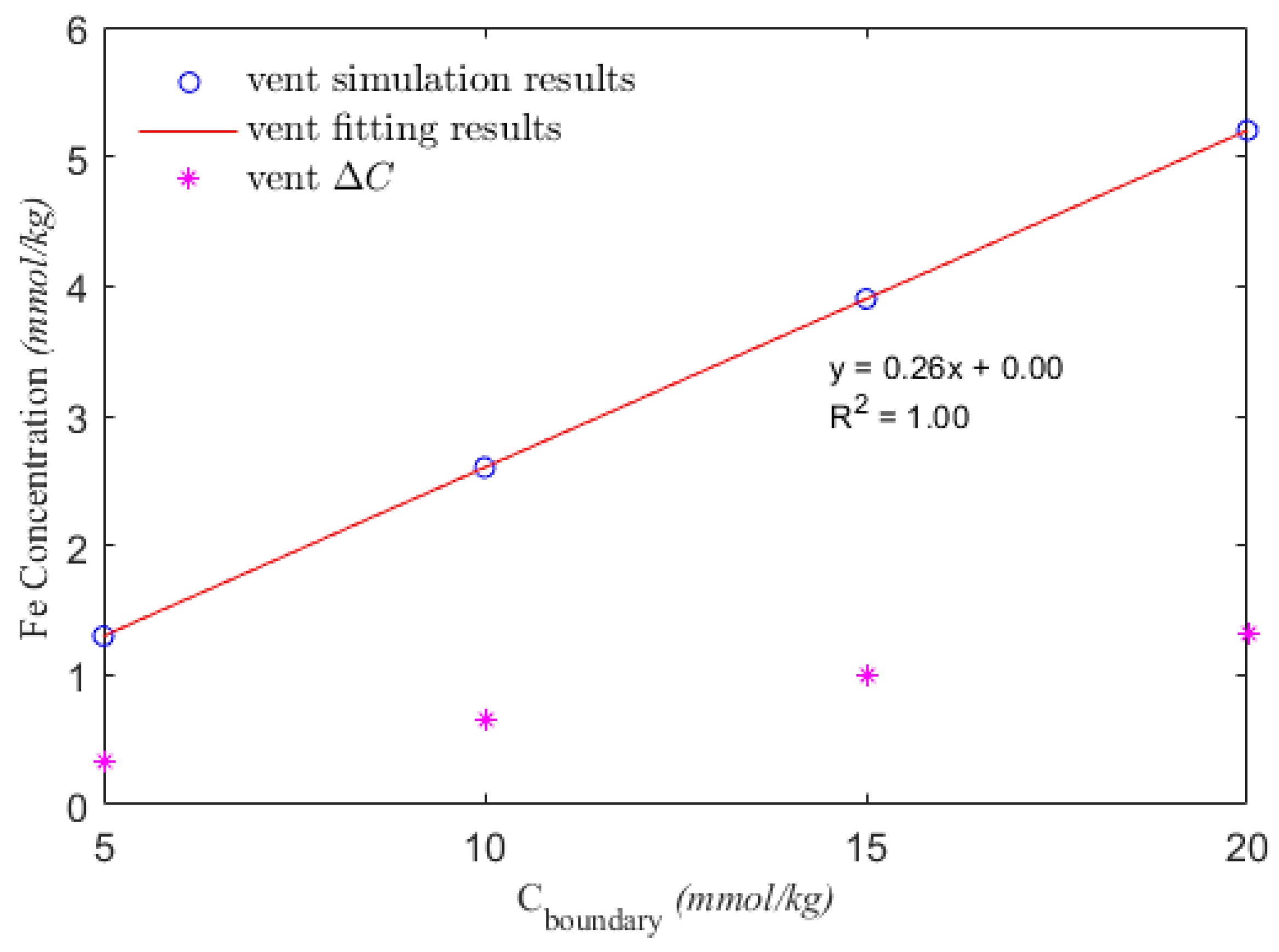
| Notation | Meaning | Value | Unit | Remarks |
|---|---|---|---|---|
| Td | Vent temperature | 359 | °C | Wang et al., 2017 [16] |
| H | Vent heat flux | 1.35 ± 0.11 | MW | Chen et al., 2022 [27] |
| Ad | Vent area | 400 | m2 | Assumption |
| Q | Flux | 0.75 ± 0.06 | kg/s | Derived from Equation (7) |
| kd | Oceanic crust permeability | 5.3 × 10−14 | m2 | Derived from Equation (8) |
| Cvent | Concentration of Fe at vent | 2.59 ± 0.03 | mmol/kg | Derived from Equation (9) |
| Cboundary | Concentration of Fe at bottom | / | mmol/kg | Sensitivity analysis |
| h | Depth of heat source | / | m | Sensitivity analysis |
| Tmax | Maximum temperature at heat source | / | °C | Sensitivity analysis |
| Cases | Heat Source Depth (h/m) | Permeability at Recharge Area (kd/m2) | Calculation Time (a) | Bottom Minimum Temperature (Tmin/°C) | Bottom Maximum Temperature (Tmax/°C) |
|---|---|---|---|---|---|
| 1.1 | 1000 | 5.3 × 10−14 | 600 | 300 | 500 |
| 1.2 | 1000 | 5.3 × 10−14 | 600 | 350 | 550 |
| 1.3 | 1000 | 5.3 × 10−14 | 600 | 400 | 600 |
| 1.4 | 1000 | 5.3 × 10−14 | 600 | 450 | 650 |
| 1.5 | 1000 | 5.3 × 10−14 | 600 | 500 | 700 |
| Cases | Heat Source Depth (h/m) | Permeability at Recharge Area (kd/m2) | Calculation Time (a) | Bottom Maximum Temperature (Tmax/°C) |
|---|---|---|---|---|
| 2.1~2.5 | 1000 | 5.3 × 10−14 | 600 | 500~700 |
| 3.1~3.5 | 500 | 5.3 × 10−14 | 600 | 500~700 |
| 4.1~4.5 | 1500 | 5.3 × 10−14 | 600 | 500~700 |
| 5.1~5.5 | 2000 | 5.3 × 10−14 | 600 | 500~700 |
| 6.1~6.5 | 2500 | 5.3 × 10−14 | 600 | 500~700 |
| Cases | Heat Source Depth (h/m) | Permeability at Recharge Area (kd/m2) | Calculation Time (a) | Bottom Fe Element Concentration (Cboundary /mmol·kg−1) |
|---|---|---|---|---|
| 7.1 | 1000 | 5.3 × 10−14 | 600 | 5 |
| 7.2 | 1000 | 5.3 × 10−14 | 600 | 10 |
| 7.3 | 1000 | 5.3 × 10−14 | 600 | 15 |
| 7.4 | 1000 | 5.3 × 10−14 | 600 | 20 |
Disclaimer/Publisher’s Note: The statements, opinions and data contained in all publications are solely those of the individual author(s) and contributor(s) and not of MDPI and/or the editor(s). MDPI and/or the editor(s) disclaim responsibility for any injury to people or property resulting from any ideas, methods, instructions or products referred to in the content. |
© 2023 by the authors. Licensee MDPI, Basel, Switzerland. This article is an open access article distributed under the terms and conditions of the Creative Commons Attribution (CC BY) license (https://creativecommons.org/licenses/by/4.0/).
Share and Cite
Zeng, H.; Hu, P.; He, Z.; Yao, J.; Yang, Z. Numerical Simulation Study of Seafloor Hydrothermal Circulation Based on HydrothermalFoam: A Case Study of the Wocan-1 Hydrothermal Field, Carlsberg Ridge, Indian Ocean. J. Mar. Sci. Eng. 2024, 12, 46. https://doi.org/10.3390/jmse12010046
Zeng H, Hu P, He Z, Yao J, Yang Z. Numerical Simulation Study of Seafloor Hydrothermal Circulation Based on HydrothermalFoam: A Case Study of the Wocan-1 Hydrothermal Field, Carlsberg Ridge, Indian Ocean. Journal of Marine Science and Engineering. 2024; 12(1):46. https://doi.org/10.3390/jmse12010046
Chicago/Turabian StyleZeng, Haoyang, Peng Hu, Zhiguo He, Jinrong Yao, and Zhiying Yang. 2024. "Numerical Simulation Study of Seafloor Hydrothermal Circulation Based on HydrothermalFoam: A Case Study of the Wocan-1 Hydrothermal Field, Carlsberg Ridge, Indian Ocean" Journal of Marine Science and Engineering 12, no. 1: 46. https://doi.org/10.3390/jmse12010046





